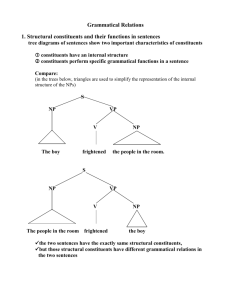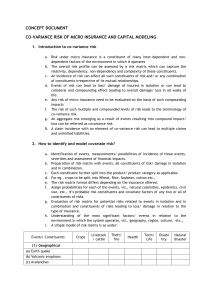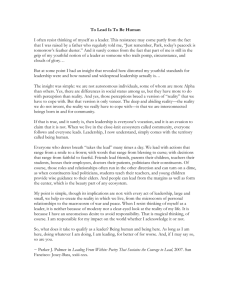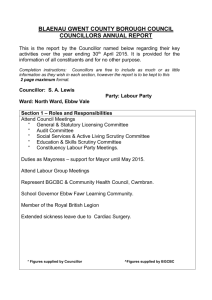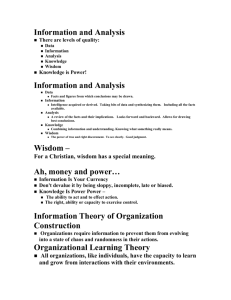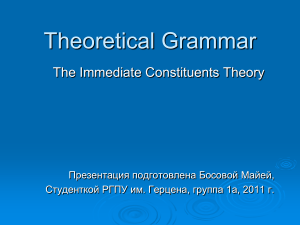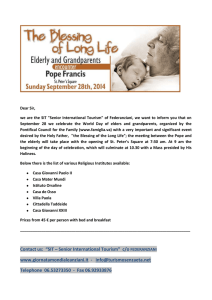From Constituents to Stakeholders - NYU Wagner
advertisement
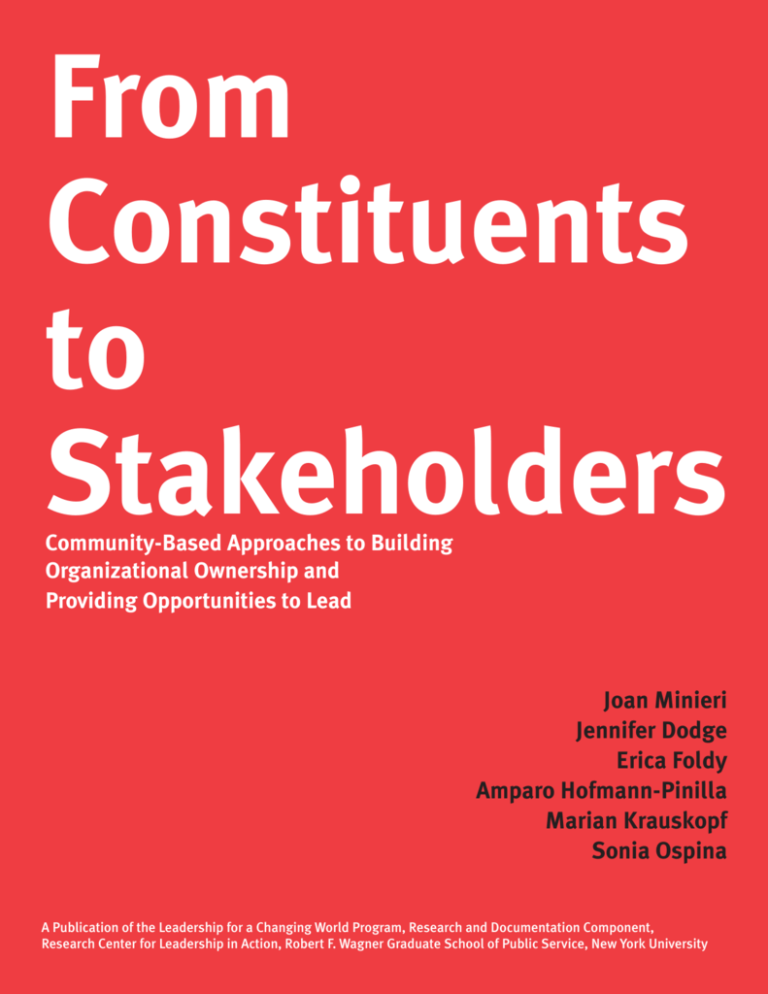
From Constituents to Stakeholders Community-Based Approaches to Building Organizational Ownership and Providing Opportunities to Lead Joan Minieri Jennifer Dodge Erica Foldy Amparo Hofmann-Pinilla Marian Krauskopf Sonia Ospina A Publication of the Leadership for a Changing World Program, Research and Documentation Component, Research Center for Leadership in Action, Robert F. Wagner Graduate School of Public Service, New York University Acknowledgements The members of the LCW Research and Documentation Team at the Research Center for Leadership in Action would like to acknowledge the many contributions of co-researchers, partners, and other social change leaders in LCW who have been active participants in shaping our learning. We want to particularly thank the Ford Foundation for its generous support for the LCW program and the Research and Documentation effort. About this publication The case examples cited here are of selected awardees of the Leadership for a Changing World program. Sponsored by the Ford Foundation in partnership with the Advocacy Institute and the Research Center for Leadership in Action, this program recognizes the contributions and distinct strategies of community-based, social change leaders. The examples illustrate the work of these organizations in 2001 and 2002. Many are now implementing new programs, engaging new issues, and building new constituencies. Some individuals now serve different roles in their organizations or have moved on. For more information about the Leadership for a Changing World program and the Research Center for Leadership in Action, please see the inside back cover of this publication. You may obtain links to the featured organizations, as well as fuller descriptions of their work at: www.wagner.nyu.edu/leadership. Contents Who Has a Stake in your Organization?................................... 2 Constituents, Stakeholders, Communities............................... 4 Case examples CASA of Maryland ............................................................... 5 The Ohio Valley Environmental Coalition.............................6 The Black AIDS Institute . .................................................... 7 Triangle Residential Options For Substance Abusers ..........8 The Gwich’in Steering Committee .......................................9 A Dance that Creates Equals.............................................. 10 Justice for Janitors ............................................................. 12 New Road Community Development Group of Exmore....... 13 Strategies for Moving Constituents to Stakeholders............. 14 1 Who has a stake in your organization? “No one is going to do it for you. We all need to put in our grain of sand.” –Rafael Ventura, former janitor/organizer, Justice for Janitors 2 Stakeholders are the people who care about an organization and consider it their own. Some obvious stakeholders include donors, board members, staff, and close allies. But many community-based organizations also seek to build the ownership of constituents—the people the organization serves, advocates for, or organizes. This document offers case examples of nonprofits that have given constituents the opportunities and skills to have a stake in their organizations. We trust that readers and their groups will be interested in learning more about these stories and in seeking ways to integrate these programs’ approaches into their own work. Developing Effective Solutions to Community Problems First and foremost, engaging constituents as stakeholders keeps organizations responsive to community needs. Because of their direct experiences, constituents often have unique views of how social service programs, community development projects, and public policies play out in their lives. When constituents participate in an organization—whether that organization exists to meet their immediate needs or to build their political power—they help ensure that the solutions it puts forward are relevant and effective. Remaining Vital When those most directly affected by the problems an organization addresses are invested in its success, they help it to remain vital and successful over time. This can include adding new program areas to expand the organization’s impact. In one example from the Ohio Valley Environmental Coalition (page 6), constituents experienced in successful organizing against devastating mining practices began to realize they had to learn a new set of skills in order to revamp the legislature and have widespread, lasting effects. Subsequent efforts to change campaign finance legislation then enabled the organization to address broader issues of political power. Early on, we realized that in talking about leadership we were not referring to individual acts as in a traditional notion of leadership. Instead, most of the stories we shared dealt with the details of close working relationships with individuals in our organizations and communities. From “A Dance that Creates Equals” (see page 10) Demonstrating a Range of Engagement CASA of Maryland (see page 5), for example, serves and organizes low-income, immigrant workers. Executive Director Gustavo Torres describes how CASA builds in opportunities throughout its programs for constituents to help shape the organization and drive its public policy agenda. He tells the compelling story of how a former domestic worker became a “national expert” testifying to Congress on the Victims of Trafficking Act, speaking from her experience. She helped CASA and its coalition members win special fast-track visa rights for people coerced to come to the U.S. as captive labor. What follows are firsthand accounts from people in the field. Their strategies for stakeholder engagement include everything from inviting community input to maintaining constituent leadership roles within the structure of their organizations. Some, like CASA, ultimately train constituents to influence public policy on behalf of their organizations—to become leaders on the social issues they know so well from firsthand experience. These examples illustrate a range of strategies and program ideas that communitybased organizations can emulate to ground and strengthen their work. 3 Constituents, stakeholders, communities Working definitions The terms constituents, stakeholders, and communities often mean different things to different people. For the purposes of this report, we define these terms as follows: Constituents Constituents are the people an organization serves, advocates for, or organizes. This includes those who share a geographic community or interest area and who directly benefit from the organization’s work. So, for example, constituents may also include those whom the organization could potentially serve or “recruit,” to use the language of organizing and membershipbased groups. Organizations generally understand constituency in multiple ways that may even evolve and change during the life of the organization. Some work on the basis of accountability: the constituents are those whom the organization must answer to for its use of resources and in evaluating its effectiveness. Some define their constituents as other organized groups, not just individuals, such as unions as well as workers. Others think of their constituents both as the people they directly engage in their programs, such as teachers, as well as those whose lives they ultimately hope to improve, such as children. Stakeholders Stakeholders are the individuals who care about an organization and consider it their own. They devote time or resources to ensure the internal development of an organization and/or its impact in the community. Internal development includes fundraising, financial management, human resources, and program oversight. Community impact includes aligning new program development with the organization’s mission. It also includes the ability to meet needs in a service organization, build the power of grassroots leaders in an organizing group, or enable constituents to publicly represent the organization and its issues. Communities Communities are groups of people who share an area of interest and/or a geographic area. Common areas of interest include social or economic conditions, health status, race, ethnicity, or gender. Geographic areas include neighborhoods, cities, or regions. 4 Integrating opportunities for ownership and leadership CASA of Maryland Creates Co-Authors of Justice “I see day laborers, domestic, and other low-wage workers actively participating in community action, in politics, in lobbying, giving testimony, talking to the media. This is a community that is ready, that is pushing us.” Gustavo Torres, Executive Director, CASA of Maryland CASA of Maryland illustrates how an organization can develop constituents into stakeholders throughout all of its programs. Like many community-based organizations, CASA uses a range of program approaches to meet its goals. CASA provides direct services for low-wage workers, primarily immigrants from countries including El Salvador and Columbia. It also organizes these workers and advocates for public policy change to improve their circumstances. CASA explicitly incorporates constituent contributions into each of its programs. The result is a powerful and energized base of stakeholders for the organization. “When you look at components of empowerment,” says Torres, “CASA is probably 10 percent, and the community is the other 90 percent.” Offering Services in Exchange for Time CASA’s employment and training centers offer services such as job training; English instruction; and health, housing, and legal counseling, but not as charity. Those in need “purchase” services by building up a bank of “time dollars” through activism and service to the organization, including work as activists. This “sweat equity” ensures that participants make important contributions to CASA, even while they are receiving needed services from the organization. Organizing Workers Where They Need It Most CASA also organizes workers, often at their initiative. For instance, it helped one group organize a slowdown at their work site because of the treatment they were receiving on the job. CASA’s organizing can also go beyond the workplace. “I was working on organizing day laborers,” says a staff member. “But they had a variety of problems from tenant issues to health care. One of our first actions was working with tenants at a group of apartments that was trying to push immigrants out.” By enabling constituent workers to drive its organizing agenda, CASA helps these workers build ownership in their common efforts. Affecting Public Policy Ultimately, Executive Director Gustavo Torres and his colleagues know that on their issues, most roads lead to public policy. CASA’s 40-hour training program gives immigrant workers the skills to begin to translate their problems into policy recommendations and to give public testimony. It is, in the words of a CASA staff member, “...a very different experience from the countries they’re from. Many aren’t even aware that the opportunity for such action even exists here.” Torres maintains, “Politicians really listen when a low-wage worker or a domestic worker or a family comes in and talks to them.” For example, a domestic worker, once held as virtual captive labor, gave CASA’s Congressional testimony on the Victims of Trafficking Act. “She was the national expert,” says a CASA activist. “She had spent untold hours talking to hundreds of other domestic workers. She was able to present across a broad sweep of experience: her own and that of others in her situation.” At CASA of Maryland, the organization directly attributes its success to giving low-wage workers the opportunities and skills to advocate for themselves and to take on leadership roles. They become true stakeholders, deeply invested in CASA’s work. “They are,” says Torres, “the co-authors of justice at every level.” 5 Getting to the root of the problem The Ohio Valley Environmental Coalition Takes on Special Interests “Everybody is hungry for community, and everybody is hungry to be treated with worth and with care, and when people treat each other with care and respect, that’s attractive to other people, and it brings other people in.” Dianne Bady, Co-Director, Ohio Valley Environmental Coalition The Ohio Valley Environmental Coalition (OVEC) in West Virginia is a community organizing group. Its work demonstrates how an organization with a grassroots political base can be more effective when those affected by its issues have the opportunity to take on important leadership roles. OVEC has long organized Appalachian communities to protect their air, water, and mountains from being destroyed by corporate interests for oil, timber, and coal. Its organizing strategies rely on engaging constituents along with other stakeholders. For example, to stop the development of a paper mill on the Ohio River, the organization held a community dinner outside a closed-door meeting of paper mill executives. The menu included dioxin-poisoned fish and glasses of polluted water. Since the company would not even commit to hiring locally for the plant’s construction, OVEC recruited the West Virginian Affiliated Construction Trades Foundation to mail out thousands of “scratch-and-sniff ” postcards to demonstrate how it would smell downwind of the proposed mill. When they were portrayed as a “band of extremists,” Dianne Bady, OVEC co-director, says, “We got the Commission on Religion in Appalachia involved, and that made things very different.” Expanding to Include Public Policy Advocacy In addition, OVEC steadfastly opposes the practice of mountaintop removal, where mining companies literally blow the tops off of mountains and dump the remains onto the homes, streams, and neighborhoods of OVEC’s constituents. Eleanor Taylor, an OVEC board member directly affected by mountaintop removal, describes how she began to realize that organizing campaigns directed at special, corporate interests would not necessarily change the broader political power dynamics that led to many of the issues in the region. “There were articles in U.S. News and World Report and Newsweek about mountaintop removal,” she says. “And I thought, all we have to do is show our state legislators those articles, and things will change. But nothing changed, and it dawned on us that nothing was going to change until we changed the legislature.” Thus, OVEC and its allies began to push for a change in an entrenched campaign finance system rooted in buying votes. OVEC is leading the way in a demanding and long-term campaign to enact legislation that offers public funding to candidates who pledge not to take money from special interests. Enabling Committed Constituents to Go Deeper Now, through the linked approaches of organizing and public policy advocacy, stakeholders like Eleanor Taylor are both protecting their communities and addressing root causes. While these approaches go hand-in-hand in many ways, they require different strategies and skills. OVEC provides the place where people can develop the capacity to act in whatever ways are needed. 6 Educating those affected by the issues The Black AIDS Institute Informs and Activates a Base of Stakeholders “Okay, you’re here now. The fact that we dragged you in here is irrelevant. So how can we structure an approach for you to play a role in the resolution to this problem?” Board Member, The Black AIDS Institute In the late 1990s, with AIDS tearing through the black community, the Los Angeles-based Black AIDS Institute launched an ambitious plan to identify black stakeholders and to educate and create community-based leadership on HIV/AIDS issues. It developed several strategies that would ultimately activate this base. With one in 160 black women and one in 50 black men diagnosed as HIV positive, “We’re talking about saving our own lives,” said Executive Director Phill Wilson. Educating Individuals and Organizations for Action The Institute maintained that the source of inaction among its constituents has been ignorance. It did not assume that information about HIV/AIDS is accessible to the black community, so the Institute addressed (and continues to address) critical gaps in knowledge. A cornerstone of its efforts is the African American HIV University, which trains 40 future leaders over a two-year period. The training includes five intensive sessions on everything from the biology and epidemiology of HIV/AIDS, to strategies for community and political action. Fellows bring this information back home through participating in internships between training sessions. The Institute further educates the community by strategically enlisting the sororities, media outlets, health care agencies, and others that already engage African Americans in large numbers. “These are our experiences, our organizations, our churches, and our leaders. We are the people we must target,” Wilson says. In addition to working directly with the black media, the Institute publishes a highly regarded newsletter, “Kujisource,” which circulates to over 20,000 readers. The newsletter includes not only profiles on “everyday heroes” working on or living with HIV/AIDS, but scientific articles and editorials on public policy as well. Meeting Potential Stakeholders Where They Are The Institute offers no recriminations for past inaction and does not simply push people to add HIV/AIDS to an already full plate. In its efforts to engage organizations as stakeholders, it works with each group, from the smallest community organization to the largest association, to help them, as an Institute director puts it, “to find out where they are in HIV/AIDS work and what they think we can do to help them with the work they are already doing.” For example, the Institute enabled Delta Sigma Theta, the nation’s largest African-American sorority, to incorporate a three-session training on HIV/AIDS into their regular meetings, as the sorority did not think people would come to three special sessions. Wilson says, “It would clearly have backfired on us if we had said, ‘No, you have to have three training sessions and that’s that.’ Instead, [we] back away and say, ‘Okay, how can we help you be successful?’ because at the end of the day, that’s what it’s all about.” 7 Empowering service recipients Triangle Residential Options For Substance Abusers Creates an Interdependent Community of Engagement “Most of the time, as addicts, we hurt people, and not just physically, but emotionally. And so all of a sudden, these residents are responsible [for each other], and they start having to get close to somebody and listen to their story and be there at night. That’s part of the emotional growth here – you start caring.” Kevin McDonald, Executive Director, Triangle Residential Options For Substance Abusers (TROSA) Triangle Residential Options for Substance Abusers (TROSA) in Durham, North Carolina, rebuilds lives while it directly enlists service recipients as stakeholders in the organization’s success. It engages constituents on two levels: internally through its direct services to help them overcome substance abuse and externally in building broader community buy-in to its mission. Rebuilding Individual Lives Internally, TROSA enables former addicts to move from “a walk down the road to hell,” according to Barbara Lau, who observed the organization in action over the course of several months. They go on to a road of “self-knowledge, accomplishment, peace, and sobriety.” Through a completely voluntary, two-year residential program, TROSA creates a “community of engagement.” Its 300 residents live and work together. “Everyone,” says Lau, “is responsible and accountable to everyone else in all crucial arenas: work, personal relationships, community relations, and individual healing and growth.” Importantly, TROSA requires new residents to immediately mentor and counsel others in the therapeutic community. “For most of our residents,” says Executive Director Kevin McDonald, “they have never come close to this level of accountability.” Building the Organization TROSA uses a social entrepreneurial model in which constituents literally do the work of the organization through tasks designed to help them heal, physically and emotionally. TROSA requires each of its residents to work in one of its business endeavors. These include a moving company, a construction division, and a catering service. TROSA funds 90% of its operating budget through these enterprises while enabling residents to earn nest eggs for financial independence. Work tasks and drug treatment “run hand in hand,” according to Mike Keene, manager of the moving company. “It’s just like in your life,” says Keene. “You’ve got to work to make money. And things happen in your life that you have to deal with.” Fostering Broad-Based Support Externally, TROSA’s goals include changing public attitudes about drug addiction and recovering addicts. Barbara Lau contends that “attitudes can change when individuals are confronted with experience that contradicts their biases.” In the interdependent community of TROSA, constituents must act as stakeholders. They have both a personal investment and a broader and critically important role in promoting the organization and its effectiveness. It is part of why it is so important for TROSA residents to interact with the Durham community as workers. “People don’t use our services because we’re drug addicts,” says Executive Director McDonald. “They use them because we do a good job.” And this exposure changes the way people think about TROSA residents. As one satisfied customer of TROSA’s moving service put it, “If these men handle the rest of their [lives] the way they handled this move and their behavior today, they will certainly be successful. Count another couple of people in their corner.” 8 Drawing strength from culture and spirituality The Gwich’in Steering Committee Fights for Its Life “There are only 7,000 of us in 15 villages, and we’re fighting multimillion-dollar corporations. So we have to get out there and teach the world. We’re not against all development; we are protecting our birth rights.” Sarah James, Spokesperson, Gwich’in Steering Committee Members of the Gwich’in Nation, which means “caribou people,” have been united, even reborn, in pursuing their steadfast goal: to prevent oil drilling in the Arctic National Wildlife Refuge. The Refuge is their home, and the calving grounds of the caribou, upon which the Gwich’in rely for food, are the foundation of their culture. According to one Gwich’in activist, “Sixty, seventy percent of the people’s diet up here comes from the land, and the number one part of their diet is caribou. Winters after the caribou have been here, everyone is happy; no one worries about food. When the caribou don’t come, it’s a totally different attitude with everybody.” Adds another activist: “The caribou out there are our life. What could be more important than fighting for your life?” Gwich’in constituents include both individuals and its 15 tribes from the U.S. and Canada. When the tribes first gathered in 1988 under the threat of oil drilling, it was the first such gathering in 100 years. The tribes are now organized as the Gwich’in Steering Committee. They meet regularly to celebrate their “wake up” call, set strategy, and draw anyone possible into their campaign, especially the next generation of Gwich’in. In addressing the threat to the caribou, the Gwich’in have reinforced their traditional, spiritual relationship with the land and the animals that roam that land. They have decreased tribal dependence on oil. Tribal leaders have evaluated their own practices and are building environmental sustainability in areas such as energy and waste disposal. “We got caught up on the Western culture of just throwing things away,” says committee spokesperson and Gwich’in elder Sarah James. “Now where we hunt and fish, it’s all clean,” she says. “We try to recycle everything.” Engaging the Next Generation The elders have prioritized educating the next generation of Gwich’in about the relationship between environmental protection and the tribe’s survival. Reflecting deeply held cultural values, a senior staff member says Gwich’in young people, “need to be able to tell their children and grandchildren what they did to protect a strong and viable Gwich’in culture.” Sarah James invites young Gwich’in to stay with her for intensive mentoring. They can then, she says, “go out into the world and speak on these issues and do well.” Redefining the Base of Potential Stakeholders The Steering Committee maintains that protecting the Refuge is not just an issue of environmental protection, but of human rights as well. It defines its own rights based on its cultural and spiritual beliefs. “We call the area, ‘the place where life begins,’” says James. “Protecting it means not only protecting animals, but also the Gwich’in way of life.” She maintains: “The creator put us here to take care of this part of the world. And for thousands of years we’ve done that, and we’ve done well. Nobody has the right to say we don’t have that right.” Making this case broadens the base of both constituents and potential stakeholders. Reaching this base is now essential to the Gwich’in strategy. The Gwich’in seek out sympathetic supporters as well as those who are similarly fighting for what they perceive to be their essential rights. James and others travel the globe to build alliances. “We used to be tucked up here, safe,” she says. “Now we are going to the public to tell our story.” 9 Creating space for leadership “Stepping Back”/“Stepping Up” Enables “A Dance that Creates Equals” “We believe that with the right support and skill base, anyone can influence the world. Regardless of formal education or training, when people have personal life experience with an issue, they have a right to be at the table – a leader on that issue.” From “A Dance that Creates Equals” by Denise Altvater, Bethany Godsoe, LaDon James, Barbara Miller, Sonia Ospina, Tyletha Samuels, Cassandra Shaylor, Lateefah Simon, and Mark Valdez Over the course of two years, a group of seven community leaders and two facilitators explored how to create space and opportunities for individuals in community-based organizations to recognize and develop their leadership. The group’s observations illustrate how an action-oriented process of developing constituents as leaders is central to building their stake in organizations. Shifting the Leadership Relationship In their report, “A Dance that Creates Equals,” the co-authors recognize the need for formal leadership training, but emphasize the need to take action. One type of action involves the choices made by individuals within organizations. Established leaders, the co-authors argue, need to “step back” at times in order to create the opportunity for others to “step up.” They maintain that since leadership is a relationship, not an individual act, true leadership development requires creating this intentional shift in the leadership relationship. “We are conscious of when we choose to back away from some aspect of our leadership role,” they write, “in order to make space for others.” Importantly, as Cassandra Shaylor, who works with women in prison through Justice Now, comments, stepping back without someone to step up is “checking out.” It is not leadership. The report cites several important factors for creating a shift in the leadership relationship: personal transformation and healing, faith in the power of personal experience, readiness, and need for support–a safe space. Creating the Space for Others to Step Up Lateefah Simon directs the Center for Young Women’s Development in San Francisco, which brings together young women inside and outside the juvenile justice system to become community leaders. Simon’s decision to step back enabled others to establish their own stake in the organization. Two young women stepped up to have a conversation with her about the new roles they wanted to take on. They asked her to take time away from the office, to make space for them, which she agreed to do. They were successful, and with distance, Simon saw that leadership development involves allowing others to do things they’re good at. Simon emphasizes how preparing young women in her organization to step up often involves healing. Simon offers the image of a wounded arm lifting a weight: you cannot lift heavy weights without first healing the wounds from past experiences. Simon’s organization offers women coming out of juvenile detention the chance to work at the Center as a way to begin to build selfconfidence and the ability to work cooperatively with other young women. This enables them to heal themselves and eventually to address community and societal healing. “A lot of the people, when we first interview them for jobs, they can’t even hold their head up,” says the Center’s Associate Director. “They can’t look you in the eye, not once in an hour-long interview. Some come in, and all they do is cry. For their whole lives the only people who’ve said they’ve loved them are their abusive parents or maybe their pimp.” At one time, says Simon, “All we did was emphasize leadership development. But those women had not gotten to a process where their wounds were closed, and we were saying, ‘Who cares? Be a leader!’” 10 From this insight, Simon has come to use the healing process as a source of strength. This is essential for creating leaders who can not only contribute to organizations, but who can take effective action on the issues that confront them. At the Center for Young Women’s Development, “we are at that cross section,” says Simon, “of not just getting people off the streets and into a program, but getting them into a program where one, they have to sit and work with each other... even if they were in rival gangs; and two, where they have to deepen their understanding of the political and social forces that have shaped their lives.” They can then work together, she maintains, “to see some kind of victory.” Who is going to be a more fierce advocate for change, Simon asks, “than somebody who knows what it’s like to be selling crack at two in the morning to pay for a hotel room in which to live?” Building Leadership, Changing Lives Once someone has stepped up, the co-authors call this “crossing over.” Tyletha Samuels went from being a member to organizational leader to staff organizer at New York City’s Community Voices Heard, which organizes low-income women for welfare reform and job creation. Her progression required confidence and support. She stepped up originally because someone offered just that, confidence and support, as well as concrete opportunities. Someone from the organization let her know that she was the expert who could address the political issues underlying her personal situation and created the space for her to see that and act on it. Once a constituent becomes a leader with a stake in an organization, it creates a powerful, even life-changing shift. The coauthors maintain this is irreversible, commenting that, “Once you have ‘crossed over’ you will never be the same.” As Samuels says, “They can’t take my leadership away.” 11 Creating a community-led agenda for change Justice for Janitors Fights for Workers and Their Community “You tell them, ‘You can fight. We’re in a country where you can fight.’” Janitor/Activist, originally from Mexico, Justice for Janitors Local 1877, SEIU, also known as Justice for Janitors, organizes the mostly immigrant janitors of the Los Angeles metropolitan area. It builds workers’ stake in the union as a way to improve their own situations and the lives of other immigrants. While janitors are highly exploited and vulnerable, the union succeeds by having workers agitate each other. With a team of janitors-turnedorganizers and a network of worker-to-worker contacts, Justice for Janitors transforms a base of constituents into stakeholders who form their own agenda for change. A Journey to Empowerment Dolores Martinez describes where her own transformation began: “They worked me 10, 12 hours a day, and they paid me for eight,” she says of her first janitor’s job in the United States. “They were squeezing the work out of me.” When SEIU 1877 first came in to try to convince workers to sign onto the union, many were afraid. They feared they’d be fired or worse, deported. According to a janitor and SEIU organizer, “We think that if we go to speak to a judge or the police to complain about an employer, the first thing that’s going to happen is they’re going to call the Immigration and Naturalization Service. That’s why the majority of people here at first don’t participate.” But Dolores Martinez had had enough. “What’s so special about the job where they mistreat you, they scream at you?” she thought. “So we took the option of going to the union to tell our story and to sign union cards.” After a three-year battle, Martinez and her coworkers won insurance benefits, job security, better wages, and more say in the working conditions. And importantly, she gained sense of immense satisfaction that she now uses to engage other workers. “I have learned how to express myself,” she says. “And the union has taught me to defend myself. You learn what you are worth. It’s a great change.” Overcoming Obstacles by Sharing Experiences At Justice for Janitors the key to overcoming fear and other obstacles is to make friend-to-friend and worker-to-worker connections. “The worker is speaking from personal experience,” Dolores Martinez says, “and that is part of our success, getting the workers to talk to one another.” Organizer Rafael Ventura concurs. “We say, when I worked in a job like yours, I didn’t have any benefits, I didn’t have anyone to protect me. They could give me more work, and I couldn’t say, ‘I won’t do it,’ because they would fire me and they wouldn’t even say, ‘Thanks. Bye!’ And I tell them about the strike I was involved in as a janitor. They threatened us. They said it was the end of the line for us. And what happened? We won the contract. We went back to work, and they didn’t fire anybody because it’s our right.” Broadening the Base...And the Agenda Once constituents are stakeholders, their interests often go beyond what personally affects them. As it builds a base of more and more workers, the organization is able to respond to broader community concerns. And for the workers involved with Justice for Janitors, the concept of community goes beyond the borders of job sites or neighborhoods to include all immigrants. One example is an effort to allow undocumented immigrants to get driver’s licenses. According to Marisela Salinas, a former janitor who is now an SEIU spokesperson: “It’s not for us, the push for driver’s licenses. A lot of us already have them. It’s for the community, for other immigrants.” 12 Asserting, sustaining constituent leadership New Road Saves Itself “This community knew what it wanted. And it wouldn’t settle for ‘you can’t have it like that, you have to do it this way.’ They didn’t want minimal cookie cutter improvements.” Town Council Member, Exmore, Virginia Residents of the New Road neighborhood in Exmore, on Virginia’s eastern shore, have revitalized their community. For decades, town officials and absentee landlords neglected them. Their houses had leaky roofs, rotten floors, and no insulation. But in 1992, residents formed the New Road Community Development Group of Exmore to address what was perhaps most symbolic of the general disdain for their community—the lack of indoor plumbing in all but a few homes. Although landlords owned three-fourths of the housing in New Road in the early 1990s, generations of families had lived there for years. Still, many of those living in the community were low-wage workers in the local agricultural, seafood, and poultry industries. They were used to feeling powerless. But with wealthy developers on the prowl, they knew they had to act. They got organized and moved forward with the goals of installing sewers and increasing home ownership. From the beginning, constituents were the organization. “Our board is made up of community people,” says longtime resident and Executive Director Ruth Wise. One local activist says their action-oriented approach is: “In whatever capacity I can do something, I’ll do it. I don’t care what it is, I’ll do it. If it helps New Road, I’ll do it.” Engaging Strategic Allies In a few years, New Road residents engaged some new and important allies. With a regional community development group and the support of the McAuley Institute, they formed an $8 million Comprehensive Community Revitalization Plan. Wise calls it simply: “Wild.” With McAuley’s support, the organization purchased 30 acres of property and 54 run-down buildings and began to develop them according to the desires of the community residents. This was all much to the shock of the local political power structure. “We gave them the hiccups when we bought all that property,” says Wise. Maintaining Involvement: Nothing Succeeds Like Success To sustain community involvement in the planning process, Wise says, “We met two and three nights a week all over the county. And everyone’s input was welcome. Someone would say, ‘Why don’t we try this or why don’t we try that?’ Anybody’s idea was as good as anybody else’s.” New Road’s persistent, community-led approach paid off in May 1998, when sewer construction finally began. When the tractors and trucks arrived, “We were hooting and hollering and yelling,” says Wise, “Here comes another one! Here comes another one!” Success is clearly another important way to motivate community members to stay involved. Now, with increased home ownership and sewers, New Road residents are not only on the map, they are participating in downtown Exmore’s revitalization. According to a town council member, “They had the vision. They were looking forward. Their work has not only made their neighborhood a better place, but it has made our town a better place. We’re very proud of the work that they did, and we’re proud of the work that’s still being done.” 13 Strategies for moving constituents to stakeholders Whether serving, advocating for, or organizing constituents, an organization can build constituents into stakeholders and expand their role in and ownership of the organization’s success. The case examples featured in this report show how this is possible through a range of approaches. Some key themes or strategies that practitioners may consider in their own groups or initiatives emerge directly from the reflections of leaders of the community-based organizations featured in this document. Their stories show how they often attribute their success to building the stake of constituents deep into the work of their organizations, not only on individual programs or specific issues. 14 Whether an organization seeks to better educate and involve constituents or develop them as organizational or community leaders, possible approaches include the following: •Start strong. As you form an organization or begin a new program, engage constituents in the planning, development, and direction of the new effort. This establishes them as stakeholders from the beginning and creates a sustainable base of support. •Amplify their voice. Constituents understand the problems they experience in direct and concrete ways. This experience has significant credibility when addressing outside audiences, particularly policymakers or government officials. Work with constituents so they can provide their own expertise, tell their stories in compelling ways, and frame needed solutions. •Support, support, support. Use education, training, and participation in real work to create the awareness of a problem and build constituents’ skills and capacity to take on ever greater levels of stakeholder responsibility. •Make it real. Stuffing envelopes or making signs may be necessary to make an effort successful, but ensure that constituents have opportunities to do something meaningful within the organization and/or as its representatives. •Exchange services for effort. Where appropriate, consider requiring constituents receiving services from an organization to give back time and effort in support of the group’s policy efforts and infrastructure. •Meet people where they are. Especially when engaging organizations (but also individuals), don’t push your ideas onto their agenda. Rather listen for where they are, build a relationship, and find ways of integrating your agenda into theirs. •Step back. If you want others to take up their leadership, it is often important for organizational or traditional leaders to create space and real opportunities for constituents to step up and take on responsibility. •Relationships matter. Creating ways for constituents to connect, share their stories, and work together can enable them to overcome fears and other obstacles and become real stakeholders. •Win early. Being able to demonstrate even small policy, administrative, or other wins to your constituents builds needed momentum and can sustain longer-term efforts towards even bigger successes. •Connect around deeply held cultural or spiritual values. Identifying a common set of ideals or cultural/spiritual values can be a powerful foundation for framing an effort and engaging constituents in a sustainable way. These, of course, are just some of the strategies that can be used to help constituents become stakeholders and help community-based organizations build their effectiveness and maintain a relevant and vibrant sense of mission. No matter how one approaches it, this process, while laborintensive and challenging at times, is critical to sustaining efforts that enrich the lives of all citizens; and ultimately strengthen our neighborhoods, towns, cities, and the country as a whole. 15 About the Research Center for Leadership in Action at the Robert F. Wagner Graduate School of Public Service, New York University The Research Center for Leadership in Action (RCLA) promotes practice-grounded, social-science based, interdisciplinary research that will help strengthen both the theory and the practice of leadership in public, nonprofit, and community-based service. The RCLA is based at New York University’s Robert F. Wagner Graduate School of Public Service. RCLA is a hub where people from multiple sectors and disciplines undertaking critical public challenges come together to explore the complexities of their work, find creative ways to address them, and create new knowledge. RCLA promotes the use of practitioners’ “learned wisdom” to further leadership theory and practice through different strategies and approaches. For more information, visit www.wagner.nyu.edu/leadership. About the Leadership for a Changing World Program Leadership for a Changing World (LCW) is a recognition program of the Ford Foundation that supports community leaders known in their own communities but not known broadly. In addition, it seeks to shift the public conversation about who are authentic leaders to include the kinds of leaders participating in this program. Each year, LCW recognizes 17-20 leaders and leadership groups. Awardees receive $115,000 and participate in bi-annual program meetings, collaborative research, and a strategic communications effort. LCW is a signature program of the Ford Foundation in partnership with the Advocacy Institute–a US-based organization that works to strengthen social justice advocacy groups in the US and around the world– and RCLA at Wagner/NYU. A critical component of LCW is the Research and Documentation Component, based at RCLA. The Research and Documentation team uses a multi-modal approach and collaborative methodologies to generate new knowledge about the process of leadership. Leadership for a Changing World awardees are co-researchers in this effort. The insights from this research are being captured in a series of reports and publications such as this booklet. Members of the Research and Documentation Project Team include: Sonia Ospina, Co-Director, RCLA and LCW Research Director Marian Krauskopf, Co-Director, RCLA Amparo Hofmann-Pinilla, RCLA Associate Director, R&D/LCW Program Director Erica Foldy, Affiliated Faculty Member Jennifer Dodge, Research Associate Sanjiv Rao, Research Assistant Elizabeth DiLauro, LCW Project Coordinator Ana Maria Carvajalino, RCLA Assistant Finance Manager For more information about Leadership for a Changing World and the Research and Documentation Component, visit www.leadershipforchange.org or call 212-992-9880. Credits Strategic Communications & Planning provided editorial support, and Steve Kulp provided design and production services on the publication. 16 NYUWagner Research Center for Leadership in Action Research Center for Leadership in Action Robert F. Wagner Graduate School of Public Service New York University 295 Lafayette Street, 2nd Floor New York, NY 10012-9604 t: 212-992-9880 e: wagner.leadership@nyu.edu http://www.nyu.edu/wagner/leadership

